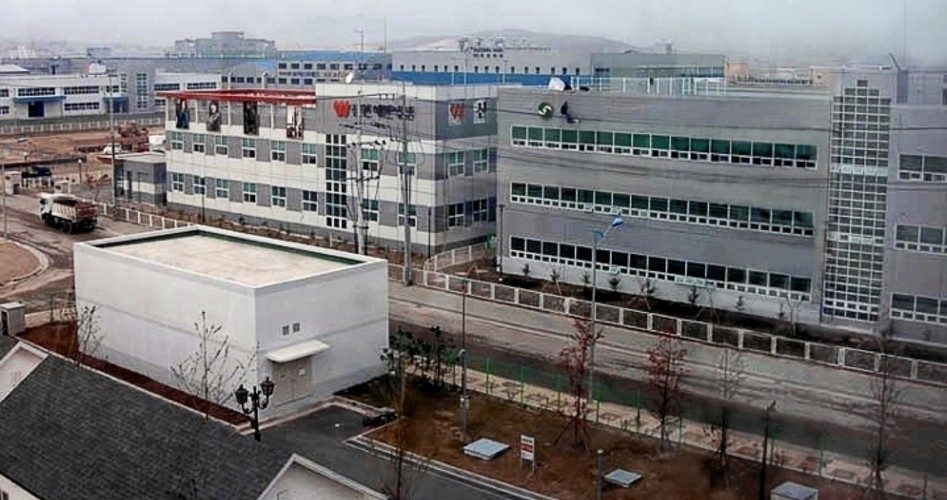
Hundreds of South Korean supervisory workers once again crossed the border between the two Koreas on September 16, to resume work at the Kaesong Industrial Complex (shown), a joint venture located just six miles north of the Demilitarized Zone.
Located within a special administrative region established by North Korea, the park allows South Korean companies to employ low-wage North Korean workers, supervised by South Korean management. Despite the ongoing tensions between the two Koreas, North Korea accedes to this arrangement because it provides the North with a steady supply of foreign currency. The 53,000 Northern workers’ wages are paid directly to the North Korean government.
The 123 South Korea-based manufacturers who have set up facilities in Kaesong, such as BK Electronics Co., which sells parts to electronics products manufacturers such as Samsung, and Sunghwa Trading Co., which makes socks and underwear for Calvin Klein, H&M, and Old Navy, see the facility as a way to remain competitive with low-wage Chinese factories. The economic advantages to both sides are enough for the two Koreas, which are more often than not at each others’ throats over political differences, to cooperate in this venture.
The Wall Street Journal reported that the two adversaries formulated an agreement last week to reopen the Kaesong park, an indication that the two Koreas are once again cooperating following a heated verbal exchange between Pyongyang and Seoul following the North’s third nuclear weapons test in February.
However, the immediate cause of the shutdown that followed in April was Pyongyang’s determination to make a statement protesting the annual military drills between Seoul and Washington, as well as its perceived insults against North Korea’s leadership.
The Journal quoted Bae Hae-dong, president of Taesung Group Co. and former chairman of the Kaesong Industrial Council that represents the interests of South Korean companies in the complex, who said that South Korean companies were committed to staying at the complex, despite the long shutdown that closed operations for more than four months.
“There’s nowhere else to go for a small- or medium-sized company like us,” said Bae. “Labor costs are just too high in the South.”
An AP report quoted another South Korean industrial manager’s views on the reopening of the Kaesong complex, Sung Hyun-sang, president of Mansun Corporation, an apparel manufacturer. “I feel good about the park’s resumption, but I also have a heavy heart,” said Sung. “We’ve suffered too much damage.”
Mansun lost about 7 billion won ($6.4 million) because of the shutdown at its Kaesong factory.
AP reported that the resumption of operations at Kaesong is an indication that tensions between the North and South have eased. The report noted: “The two Koreas plan to hold a reunion of families separated by the Korean War next week for the first time in three years, and are pushing to hold talks on resuming lucrative tours to a scenic North Korean mountain.”
A report from MSN.com quoted a South Korean textile company manager with a plant at Kaesong who viewed the resumption of production with caution. “Honestly, I still feel a bit nervous because you never know whether the North will change its mind in the future,” the manager told AFP.
“Who knows if a crisis like this won’t happen again?”
Tensions in the Korean Peninsula date back to the aftermath of World War II, when the land was divided at the 1945 Potsdam Conference (attended by Soviet dictator Joseph Stalin, British Prime Ministers Winston Churchill and Clement Atlee, and President Harry Truman) without consulting the Koreans, which was a violation of the 1943 Cairo Conference (attended by Roosevelt, Churchill, and Chinese leader Chiang Kai-shek) at which a statement had been adopted declaring that “in due course Korea shall become free and independent.”
During the UN-controlled “police action” that occurred from 1950-1953, General Douglas MacArthur, the commander of the international forces aiding South Korea, was denied authorization to pursue a strategy for victory and was relieved of his command by President Truman, following the reading of his famous letter on the floor of the House of Representatives that ended, “There is no substitute for victory.”
With fighting bogged down along the 38th Parallel, a cease-fire armistice agreement was signed on July 27, 1953. Though the agreement ended the fighting, the war was never officially ended, and tensions between the North and South have continued ever since. The United States maintains 28,500 soldiers, sailors, airmen, and Marines in South Korea, as a deterrent to Northern aggression. This, of course, presents the risk of having the United States drawn into another war in Korea, should tensions between the North and South escalate.



